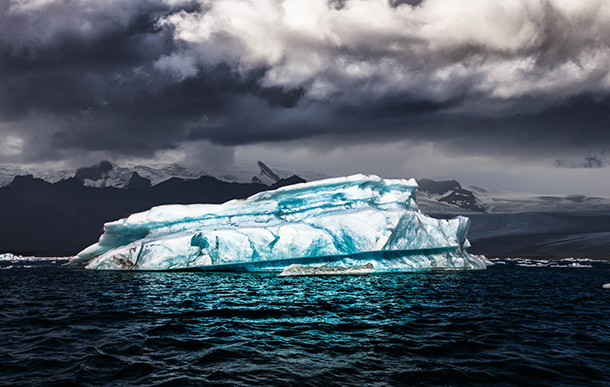Emerging Science Note/Carbon-Cleaning Icebergs
Air Date: Week of March 11, 2016

When icebergs melt, algal blooms form, storing carbon beneath the sea. (Photo: Vincent Moschetti, Flickr CC BY-NC-ND 2.0)
Living On Earth’s Jaime Kaiser reports on a new study about Antarctic Icebergs, which suggests that as they melt they release nutrients that cause algal blooms that then sequester carbon from the atmosphere in the deep ocean when they die.
Transcript
CURWOOD: Just ahead...penguins in love and in trouble. But first this note on emerging science from Jaime Kaiser.
[SCIENCE NOTE THEME]
KAISER: The giant icebergs that break off the Antarctic ice sheet contribute to rising sea levels and threaten a host of environmental consequences. Yet a new study shows these bergs also offer a surprising upside – an occasion where nature combats global warming.
A team of researchers from the University of Sheffield in England caught on to the benefit of melting icebergs using satellite images of 17 “giants”, some over 11 miles wide, as they drifted through the southern ocean. The images revealed swaths of algae where the bergs had been. The algae’s the result of iron and other nutrients the ice releases as it melts. This ocean fertilization can last over a month after the iceberg has drifted on. While algal growths lead to hypoxic “dead zones” in places like the Northern Gulf of Mexico and river ecosystems, in the Southern ocean surrounding Antarctica it’s a different story. Here, the blooms slow down warming with their knack for sequestering carbon, that then sinks to the bottom of the sea as the algae mats die.
At the moment, global greenhouse gas emissions are increasing at about 2% a year. But Grant R. Bigg, one the study’s authors, estimates that without these giant melting icebergs, and the carbon they help store deep under the sea, emissions would be growing at 2.1 or 2.2 percent each year.
But Professor Bigg warns that trying to geo-engineer algal blooms probably wouldn't be worth the cost, nor could human attempts penetrate the deeper ocean layers as effectively as icebergs. So a campaign to sprinkle iron across the world’s oceans is no substitute for reducing our carbon footprint.
That's this week's note on emerging science. I'm Jaime Kaiser.
Links
The study, “Enhanced Southern Ocean marine productivity due to fertilization by giant icebergs”
Living on Earth wants to hear from you!
Living on Earth
62 Calef Highway, Suite 212
Lee, NH 03861
Telephone: 617-287-4121
E-mail: comments@loe.org
Newsletter [Click here]
Donate to Living on Earth!
Living on Earth is an independent media program and relies entirely on contributions from listeners and institutions supporting public service. Please donate now to preserve an independent environmental voice.
NewsletterLiving on Earth offers a weekly delivery of the show's rundown to your mailbox. Sign up for our newsletter today!
 Sailors For The Sea: Be the change you want to sea.
Sailors For The Sea: Be the change you want to sea.
 The Grantham Foundation for the Protection of the Environment: Committed to protecting and improving the health of the global environment.
The Grantham Foundation for the Protection of the Environment: Committed to protecting and improving the health of the global environment.
 Contribute to Living on Earth and receive, as our gift to you, an archival print of one of Mark Seth Lender's extraordinary wildlife photographs. Follow the link to see Mark's current collection of photographs.
Contribute to Living on Earth and receive, as our gift to you, an archival print of one of Mark Seth Lender's extraordinary wildlife photographs. Follow the link to see Mark's current collection of photographs.
 Buy a signed copy of Mark Seth Lender's book Smeagull the Seagull & support Living on Earth
Buy a signed copy of Mark Seth Lender's book Smeagull the Seagull & support Living on Earth

